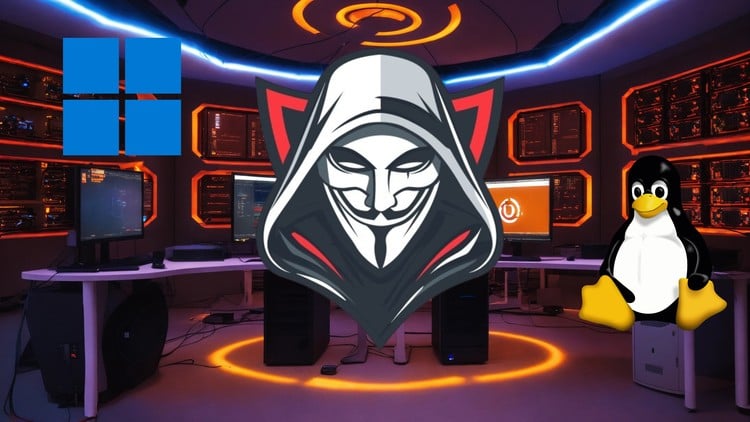
Master the Essentials of Windows & Linux Operating Systems for Cybersecurity Success
⭐ 4.54/5 rating
👥 5,159 students
🔄 December 2024 update
Add-On Information:
Note➛ Make sure your 𝐔𝐝𝐞𝐦𝐲 cart has only this course you're going to enroll it now, Remove all other courses from the 𝐔𝐝𝐞𝐦𝐲 cart before Enrolling!
-
Course Overview
- This comprehensive course offers an unparalleled journey into the intricate world of cybersecurity, specifically focusing on the two dominant operating systems: Windows and Linux.
- Meticulously designed for aspiring and current cybersecurity professionals, system administrators, and IT enthusiasts, it aims to solidify understanding of OS-level security.
- We move beyond surface-level concepts, delving deep into the architecture, security mechanisms, and common vulnerabilities inherent in both environments.
- The curriculum provides a holistic perspective, acknowledging that robust defense requires proficiency in securing both widely deployed platforms.
- You will explore critical differences and commonalities in their security paradigms, preparing you for diverse real-world threat landscapes.
- Our updated content reflects the latest security challenges and best practices, making it highly relevant for today’s dynamic cyber environment.
-
Requirements / Prerequisites
- A basic understanding of computer operations and general familiarity with either Windows or Linux graphical user interfaces is recommended.
- No prior cybersecurity expertise is strictly required, but a strong desire to learn complex technical concepts is highly beneficial.
- You will need a stable internet connection and a computer capable of running virtualization software (e.g., VirtualBox, VMware Workstation Player) with at least 8GB RAM (16GB preferred) and 50GB free storage.
- Administrative privileges on your host machine are necessary for setting up virtual lab environments and installing essential tools.
- A willingness to experiment, troubleshoot, and delve into command-line interfaces on both operating systems is crucial for hands-on success.
-
Skills Covered / Tools Used
- You will acquire a robust toolkit of practical cybersecurity skills applicable to both Windows and Linux environments, allowing you to effectively harden and secure systems from the ground up.
- Operating System Hardening: Master secure system configurations, disabling unnecessary services, and managing user accounts/permissions (least privilege) on both platforms.
- Network Security Fundamentals: Configure host-based firewalls (Windows Defender Firewall, iptables, UFW), analyze traffic, and identify common network-based attack vectors.
- Advanced Access Control: Implement Local Security Policy, Group Policy Objects (GPOs) in Windows, and comprehensive file permissions (rwx, SUID/SGID, ACLs, SELinux/AppArmor) in Linux.
- Logging & Monitoring: Develop expertise in reviewing security event logs (Event Viewer) and system logs (syslog, journald), identifying suspicious activities for basic alerting.
- Vulnerability Assessment & Mitigation: Understand OS-specific vulnerabilities, perform manual inspection, and implement proactive measures to mitigate risks.
- Basic Incident Response: Learn foundational steps for identifying compromises, system isolation, and initial evidence collection on both OS types.
- Scripting for Automation: Gain an introduction to automating security tasks using Bash in Linux and PowerShell in Windows to enhance operational efficiency.
- Command-Line Proficiency: Achieve high proficiency with Command Prompt, PowerShell, and Bash/Zsh for comprehensive system administration and security tasks.
- Key Tools & Utilities Covered:
- Windows: Command Prompt, PowerShell, Registry Editor, Task Manager, Event Viewer, Local Security Policy, Group Policy Editor, Windows Defender Firewall, Sysinternals Suite (Process Explorer, Autoruns, PsExec).
- Linux: Bash, SSH, apt/yum/dnf package managers, systemctl, journalctl, grep, awk, sed, ls, chmod, chown, sudo, iptables/UFW, netstat/ss, tcpdump, Wireshark (analysis), common utilities within a Kali Linux environment for basic recon and analysis.
- Virtualization: Practical use of VirtualBox or VMware for creating isolated lab environments.
-
Benefits / Outcomes
- By the end of this deep dive, you will possess a profound understanding of how to secure, audit, and defend both Windows and Linux operating systems, a highly sought-after skill set.
- You will be equipped to identify, analyze, and mitigate a wide array of OS-level vulnerabilities, significantly enhancing your value to any organization.
- The practical, hands-on experience gained will foster critical thinking and problem-solving abilities, enabling you to confidently tackle complex security challenges.
- This course lays a robust foundation for advanced cybersecurity roles such as Security Analyst, Penetration Tester, System Administrator with a security focus, and Incident Responder.
- It also serves as an excellent preparatory step for industry-recognized certifications that cover OS security aspects, giving you a competitive edge in the job market.
- You will gain the confidence to navigate and secure diverse IT infrastructures, ensuring robust protection against modern cyber threats.
-
PROS
- Dual-Platform Mastery: In-depth coverage of both Windows and Linux security, essential for real-world IT environments.
- Highly Practical: Hands-on labs and real-world scenarios ensure actionable, job-ready skills.
- Current & Relevant: December 2024 update addresses the latest security practices and challenges.
- Strong Career Foundation: Builds vital OS security understanding for any cybersecurity path.
- Proven Quality: High student rating (4.54/5) and large enrollment (5,159 students) demonstrate effectiveness.
-
CONS
- Significant Commitment: The “deep dive” nature requires substantial dedication, time investment, and self-motivation to master the extensive technical material.
Learning Tracks: English,IT & Software,Operating Systems & Servers
Found It Free? Share It Fast!